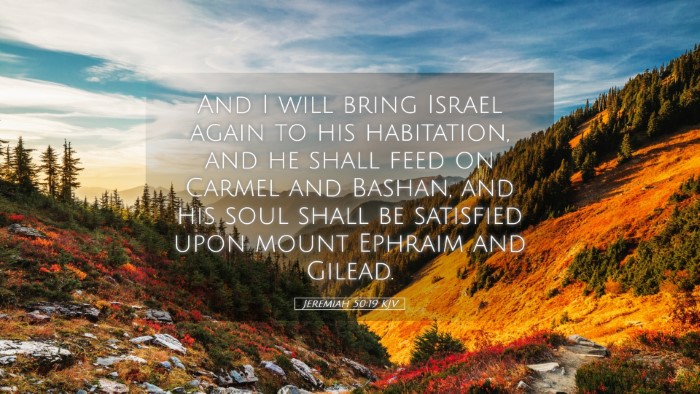Commentary on Jeremiah 50:19
Introduction
Jeremiah 50:19 offers profound insights into God's promises of restoration for Israel amidst their suffering and exile. This verse states:
"And I will bring Israel again to his habitation, and he shall feed on Carmel and Bashan, and his soul shall be satisfied upon mount Ephraim and Gilead."
This passage encapsulates God's commitment to His people and their ultimate revival, revealing significant theological themes. The following sections synthesize insights from public domain commentaries, providing a meaningful exploration for pastors, students, theologians, and Bible scholars.
Divine Restoration
The Promise of Return
At its core, Jeremiah 50:19 serves as a promise of restoration. Matthew Henry emphasizes the significance of "bringing Israel again to his habitation," indicating a return not just to a physical location but to a state of favor and peace with God. This promise is reflective of God's everlasting covenant, where He pledges to bring His people back from the diaspora.
Albert Barnes notes that this restoration signifies a return to the abundance of resources and spiritual nourishment symbolized by "Carmel and Bashan." These locations were known for their richness; thus, God's people are promised a life filled with vitality and sustenance once again.
Spiritual Nourishment
Feeding on Abundance
The imagery of feeding evokes thoughts of nourishment not only in a physical sense but spiritually. Adam Clarke elaborates on the implications of feeding on “Carmel and Bashan,” articulating the depths of spiritual satisfaction and fulfillment God desires for His people. He argues that it symbolizes a restoration of spiritual well-being, where the people of Israel would thrive in their relationship with God.
This nuance is crucial for theologians and pastors, as it underscores the holistic nature of divine restoration. The blessings of God encompass both the material and the spiritual, advocating for a theology that recognizes the interconnectedness of these aspects in the believer's life.
The Symbolism of Locations
Carmel and Bashan
In biblical literature, locations often carry layers of meaning. Carmel represents beauty and fertility, suggesting that the restoration includes not only sustenance but also the richness of beauty in God’s creation. On the other hand, Bashan is often associated with strength and fertility as well; thus, God’s promise indicates a restoration of not just physical provision but also strength and vitality to His people.
Barnes further elaborates that the references to "mount Ephraim and Gilead" highlight God's affirmation of tribal identities and inheritance. In returning, the nation of Israel would find restoration not just in abundance, but in their identity and heritage. This notion is particularly resonant for pastors and church leaders who seek to guide their congregations towards understanding their identity in Christ as part of the new covenant community.
Theological Implications
Lessons on Hope and Restoration
This verse serves as a beacon of hope in times of despair, indicating that no matter the depth of suffering, God’s promises are firm. For students and scholars of theology, the message in Jeremiah 50:19 is critical in understanding God’s unending faithfulness. The mention of satisfaction and fulfillment reinforces God’s character as one who desires to bless His people abundantly.
Additionally, the narrative context of this verse is essential. The Babylonian exile was a period marked by intense suffering. Therefore, God’s assurance through Jeremiah offers a turning point and illuminates the nature of God as a redeemer, showing how even in exile, hope prevails.
Pastoral Application
Encouragement amidst Trials
For pastors, the exhortation in this verse can serve as powerful encouragement for congregants facing despair. The promise of return and satisfaction can be a source of comfort for those experiencing their own metaphorical exiles—be it through grief, loss, or spiritual desolation. In preaching this text, pastors can highlight God’s unwavering commitment to His people and instill hope for a future filled with divine abundance.
Conclusion
Jeremiah 50:19, through its rich imagery and profound promise, encapsulates the themes of restoration, identity, and divine provision. By drawing from public domain commentaries, a comprehensive understanding emerges that meets the needs of various audiences—be it pastors seeking to encourage their flocks, students examining theological implications, or scholars diving deeper into biblical narratives.
The message remains clear: No matter the circumstances, God’s promises will prevail, assuring His people of a return to life, satisfaction, and an abiding relationship with Him.


